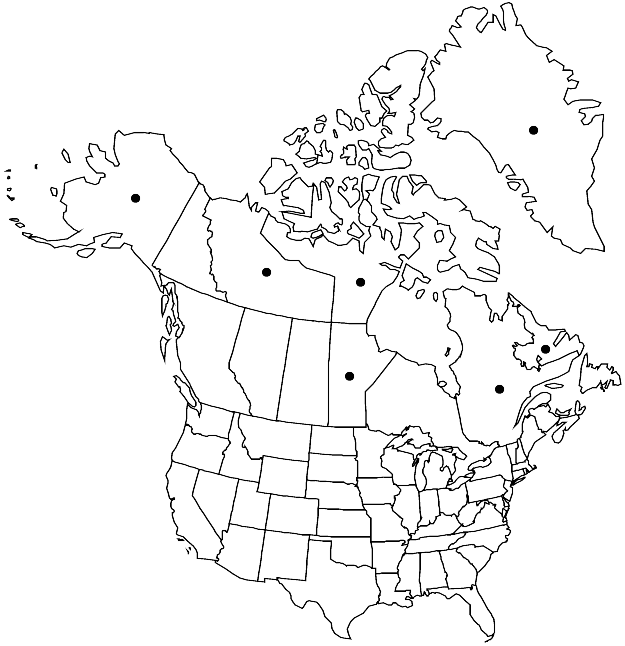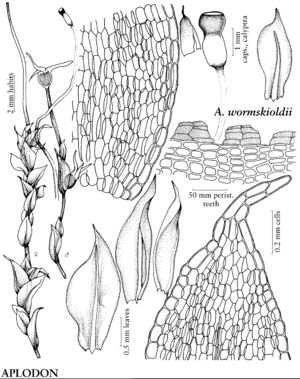Difference between revisions of "Aplodon wormskioldii"
Chlor. Melvill., 41. 1823.
Selected by author to be illustrated
Basionym: Splachnum wormskioldii Hornemann
Synonyms: Tayloria wormskioldii (Hornemann) Lindberg Tetraplodon wormskioldii (Hornemann) Lindberg
Treatment appears in FNA Volume 28. Treatment on page 29.
FNA>Volume Importer |
FNA>Volume Importer |
||
| Line 18: | Line 18: | ||
|name=Tayloria wormskioldii | |name=Tayloria wormskioldii | ||
|authority=(Hornemann) Lindberg | |authority=(Hornemann) Lindberg | ||
| − | }}{{Treatment/ID/Synonym | + | }} {{Treatment/ID/Synonym |
|name=Tetraplodon wormskioldii | |name=Tetraplodon wormskioldii | ||
|authority=(Hornemann) Lindberg | |authority=(Hornemann) Lindberg | ||
| Line 36: | Line 36: | ||
|elevation=low to moderate elevations | |elevation=low to moderate elevations | ||
|distribution=Greenland;Man.;Nfld. and Labr. (Labr.);N.W.T.;Nunavut;Que.;Alaska;n Eurasia. | |distribution=Greenland;Man.;Nfld. and Labr. (Labr.);N.W.T.;Nunavut;Que.;Alaska;n Eurasia. | ||
| − | |discussion=<p>Aplodon wormskioldii can be distinguished by the hyaline, slender and twisted seta. The gametophyte differs from other species of Splachnaceae in having shorter and much wider apical cells and a wider marginal row of laminal cells.</p> | + | |discussion=<p><i>Aplodon wormskioldii</i> can be distinguished by the hyaline, slender and twisted seta. The gametophyte differs from other species of Splachnaceae in having shorter and much wider apical cells and a wider marginal row of laminal cells.</p> |
|tables= | |tables= | ||
|references= | |references= | ||
| Line 60: | Line 60: | ||
|publication year=1823 | |publication year=1823 | ||
|special status=Selected by author to be illustrated | |special status=Selected by author to be illustrated | ||
| − | |source xml=https://jpend@bitbucket.org/aafc-mbb/fna-data-curation.git/src/ | + | |source xml=https://jpend@bitbucket.org/aafc-mbb/fna-data-curation.git/src/8f726806613d60c220dc4493de13607dd3150896/coarse_grained_fna_xml/V28/V28_26.xml |
|genus=Aplodon | |genus=Aplodon | ||
|species=Aplodon wormskioldii | |species=Aplodon wormskioldii | ||
Revision as of 18:04, 18 September 2019
Stems with branches often flagellate. Leaves shrunken when dry, erectopatent when moist, concave, 1–1.5 × 2–3 mm; costa sometimes 2-fid. Perichaetia terminal on axillary branches. Seta hyaline, very slender. Capsule 1.5–2 × 0.5–1 mm including hypophysis; columella included; exostome teeth of 2 layers of cells, short, truncate. Spores yellow-green.
Phenology: Capsules mature summer.
Habitat: Dung, animal remains
Elevation: low to moderate elevations
Distribution

Greenland, Man., Nfld. and Labr. (Labr.), N.W.T., Nunavut, Que., Alaska, n Eurasia.
Discussion
Aplodon wormskioldii can be distinguished by the hyaline, slender and twisted seta. The gametophyte differs from other species of Splachnaceae in having shorter and much wider apical cells and a wider marginal row of laminal cells.
Selected References
None.
Lower Taxa
None.
